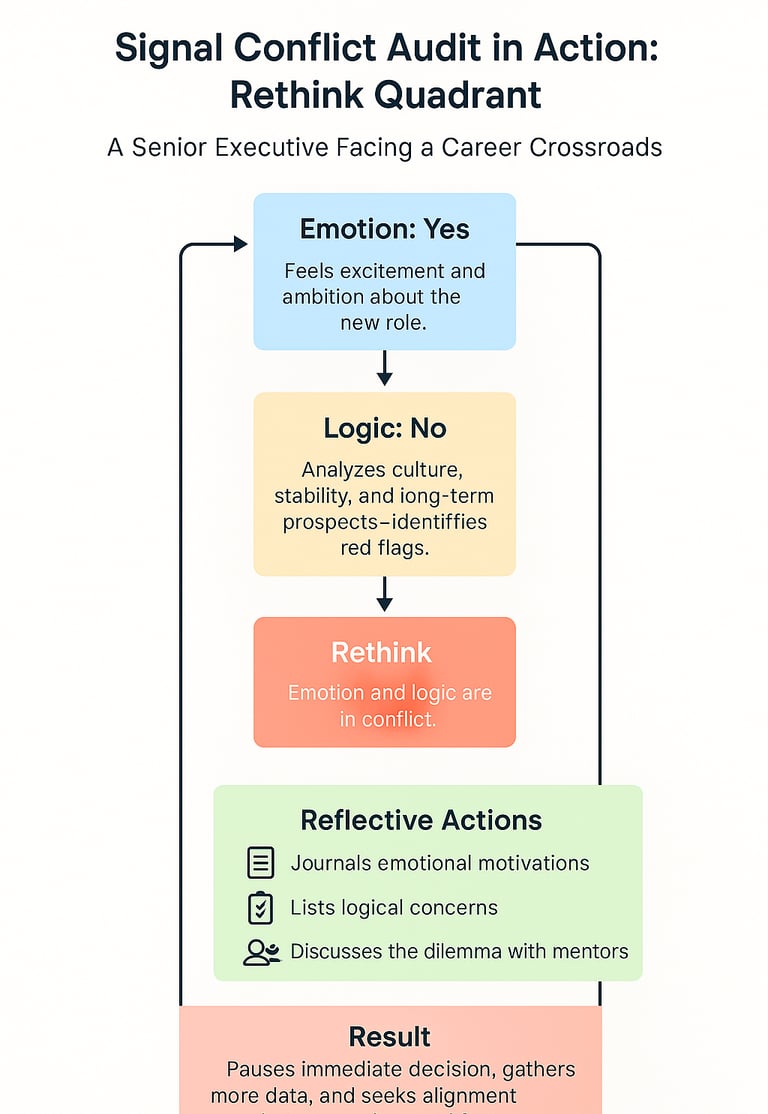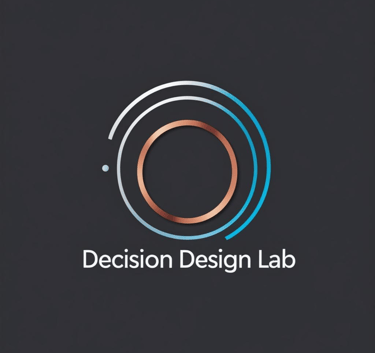Signal Conflict Audit Matrix
Overview
Signal Conflict Audit™ (SCA™) is a newly developed decision matrix that helps individuals and teams identify, map, and engage with internal conflicts between logic and emotion.
Most decision frameworks optimise logic.Yet, some of our most consequential decision pain arises not from data scarcity, but from an inner split, when our mind and heart disagree.
The Signal Conflict Audit™ Positioned as an original adaptation of the classical decision matrix, offers a simple, structured 2×2 decision matrix to help individuals and teams identify, interpret, and reflect on internal signal conflict between cognition and emotion.
Through four quadrants Green Light, Slow Down, Rethink, and Let Go users gain clarity on where their impulses and reasoning align or diverge, enabling more conscious and aligned decision-making.
Origin
Developed by Anshuman Bajpai at Decision Design Lab in 2025, SCA™ adapts the classic 2×2 decision-matrix structure to focus on internal cognitive-emotional tension.
It builds on legacy frameworks like the BCG, Eisenhower, and Johari matrices but adds a fresh dimension by directly addressing decision paralysis and internal misalignment.
Evolution
Originally conceived for air-to-air combat, the OODA Loop has been adapted for broader applications. Its principles have been applied in business strategy, cybersecurity, and law enforcement. The framework's emphasis on rapid decision-making and adaptability has made it a valuable tool in various high-stakes environments .
Significant Use Cases
Executive Coaching:
A CXO facing a major hiring decision uses SCA™ to clarify why she hesitates, her logic says the candidate is perfect on paper, but her gut signals a mismatch in values (Quadrant: Rethink). She slows the process to probe her intuition, leading to a better-aligned hire.
Therapy & Self-Reflection:
An individual stuck in a loop about whether to stay in a relationship maps their conflicting signals. Seeing they’re in “Let Go,” they realize both logic and emotion are pointing toward closure, empowering them to act (Quadrant: Let Go).
Conflict Resolution:
Two business partners keep revisiting the same argument. A mediator uses SCA™ to map their internal states, revealing that while both logically agree on a path forward, one partner’s emotional resistance (Quadrant: Slow Down) needs to be voiced and processed.
Aligned Action:
A senior leader recognises mounting frustration in her current corporate role, her motivation and engagement have waned as the company’s outlook dims, cash flow erodes, and future prospects grow uncertain. She reflects deeply and finds that her emotions clearly signal the need for change (“Yes”). Her logic, analysing financials, industry trends, and long-term fit ,also supports moving on (“Yes”).
Mapping this alignment (Quadrant: Green Light) she decides to pursue her own entrepreneurial venture, confident that both reason and intuition are backing the leap. This clarity enables decisive action and a smoother transition.
Use Case Categories
Personal & Career Decisions
Organisational Strategy & Team Alignment
Coaching & Therapy Contexts
Conflict Resolution & Mediation
Sample Use Cases and Step-by-Step Guide
Example 1: The Executive Career Dilemma
Situation
A senior executive is offered a high-profile role at a competing firm. She feels excitement and ambition about the opportunity (emotion: Yes), but after analysing the culture, stability, and long-term prospects, her logic signals caution (logic: No).
Signal Mapping
Emotion: Yes
Logic: No
Quadrant: Rethink
Reflection in Action
Instead of being paralysed by indecision, the executive uses the Signal Conflict Audit™ to clarify the real source of her tension.
She journals about what’s emotionally compelling (recognition, challenge, escape from stagnation).
She lists the logical concerns (team dynamics, brand reputation, compensation risk).
She discusses the split with mentors, consciously naming her “Rethink” status.
Result
By mapping her conflict, she doesn’t rush to accept or decline. Instead, she pursues more data, asks targeted questions, and aligns her next steps with both her values and logic.
This application moves SCA™ from a theoretical tool to a practical compass ,making the invisible visible and actionable.
Example 2: Leadership Team Offsite, Unlocking Stalled Strategy
Situation:
A leadership team at a fast-scaling tech start-up gathers for a quarterly offsite. They’ve been unable to agree on whether to pivot their product strategy. Discussions repeatedly stall, with heated debates but little progress.
Signal Mapping:
Team’s Logic: The data (user churn, revenue, competitor moves) says a pivot is necessary (logic: Yes)
Team’s Emotion: There’s deep emotional attachment to the current product vision, and fear of abandoning “their baby” (emotion: No)
Quadrant: Slow Down
Facilitation in Action:
A facilitator introduces the Signal Conflict Audit™ to surface the underlying emotional hesitation. Each leader is asked to privately score their logic and emotion signals, then share their quadrant.
The “Slow Down” result is discussed openly, acknowledging both the rational need for change and the collective emotional resistance.
The facilitator uses this awareness to pause the decision, create space for processing loss/fear, and then guides the group to re-engage with both data and values.
Result:
The team’s decision process is unblocked ,not by forcing consensus, but by legitimizing and naming the internal conflict. They agree to a phased approach, allowing time to honour what’s being left behind while preparing for the pivot.
This demonstrates SCA™ as a tool not just for mapping disagreement, but for creating dialogue and psychological safety at the group level.
Decision Design Lab Interpretation
At DDL, we view SCA™ as not just a diagnostic tool, but a reflective compass. It emphasizes understanding the internal decision landscape rather than enforcing a single path forward, SCA™ encourages clarity, dialogue, and alignment as precursors to effective action.
Scholarly Links
Rethinking Reflective Practice: John Boyd's OODA Loop as an Alternative to Kolb
Automating the OODA Loop in the Age of Intelligent Machines
Essential Reads & Interpretations
Kahneman, D., & Tversky, A. (1979). Prospect Theory: Analysis of Decision under Risk.
Covey, S. R. (1989). The 7 Habits of Highly Effective People.
BCG. (1970). The Product Portfolio Matrix.
Luft, J., & Ingham, H. (1955). Johari Window: Awareness in Interpersonal Relations.
Author/Framework Website
Anshuman Bajpai: Creator of SCA™, Founder of Decision Design Lab
Decision Design Lab: Adaptive framework design and coaching
Platforms: SSRN & ResearchGate
Connect: decisiondesignlab.com | anshumanb@decisiondesignlab.com
Video Links




